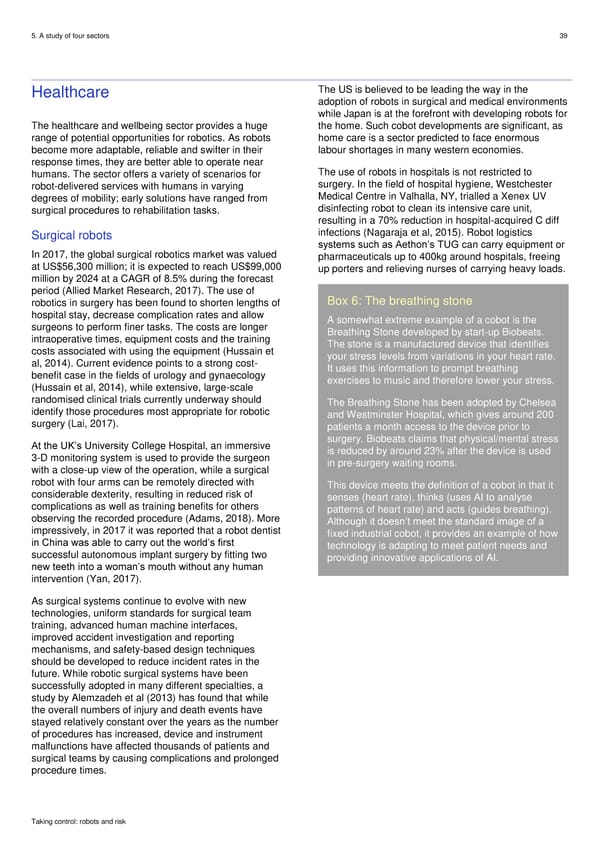5. A study of four sectors 39 Healthcare The US is believed to be leading the way in the adoption of robots in surgical and medical environments while Japan is at the forefront with developing robots for The healthcare and wellbeing sector provides a huge the home. Such cobot developments are significant, as range of potential opportunities for robotics. As robots home care is a sector predicted to face enormous become more adaptable, reliable and swifter in their labour shortages in many western economies. response times, they are better able to operate near The use of robots in hospitals is not restricted to humans. The sector offers a variety of scenarios for surgery. In the field of hospital hygiene, Westchester robot-delivered services with humans in varying Medical Centre in Valhalla, NY, trialled a Xenex UV degrees of mobility; early solutions have ranged from disinfecting robot to clean its intensive care unit, surgical procedures to rehabilitation tasks. resulting in a 70% reduction in hospital-acquired C diff Surgical robots infections (Nagaraja et al, 2015). Robot logistics In 2017, the global surgical robotics market was valued systems such as Aethon’s TUG can carry equipment or at US$56,300 million; it is expected to reach US$99,000 pharmaceuticals up to 400kg around hospitals, freeing million by 2024 at a CAGR of 8.5% during the forecast up porters and relieving nurses of carrying heavy loads. period (Allied Market Research, 2017). The use of Box 6: The breathing stone robotics in surgery has been found to shorten lengths of hospital stay, decrease complication rates and allow A somewhat extreme example of a cobot is the surgeons to perform finer tasks. The costs are longer Breathing Stone developed by start-up Biobeats. intraoperative times, equipment costs and the training The stone is a manufactured device that identifies costs associated with using the equipment (Hussain et your stress levels from variations in your heart rate. al, 2014). Current evidence points to a strong cost- It uses this information to prompt breathing benefit case in the fields of urology and gynaecology exercises to music and therefore lower your stress. (Hussain et al, 2014), while extensive, large-scale randomised clinical trials currently underway should The Breathing Stone has been adopted by Chelsea identify those procedures most appropriate for robotic and Westminster Hospital, which gives around 200 surgery (Lai, 2017). patients a month access to the device prior to At the UK’s University College Hospital, an immersive surgery. Biobeats claims that physical/mental stress 3-D monitoring system is used to provide the surgeon is reduced by around 23% after the device is used with a close-up view of the operation, while a surgical in pre-surgery waiting rooms. robot with four arms can be remotely directed with This device meets the definition of a cobot in that it considerable dexterity, resulting in reduced risk of senses (heart rate), thinks (uses AI to analyse complications as well as training benefits for others patterns of heart rate) and acts (guides breathing). observing the recorded procedure (Adams, 2018). More impressively, in 2017 it was reported that a robot dentist Although it doesn’t meet the standard image of a fixed industrial cobot, it provides an example of how in China was able to carry out the world’s first technology is adapting to meet patient needs and successful autonomous implant surgery by fitting two providing innovative applications of AI. new teeth into a woman’s mouth without any human intervention (Yan, 2017). As surgical systems continue to evolve with new technologies, uniform standards for surgical team training, advanced human machine interfaces, improved accident investigation and reporting mechanisms, and safety-based design techniques should be developed to reduce incident rates in the future. While robotic surgical systems have been successfully adopted in many different specialties, a study by Alemzadeh et al (2013) has found that while the overall numbers of injury and death events have stayed relatively constant over the years as the number of procedures has increased, device and instrument malfunctions have affected thousands of patients and surgical teams by causing complications and prolonged procedure times. Taking control: robots and risk
 Robots & Risk Page 38 Page 40
Robots & Risk Page 38 Page 40